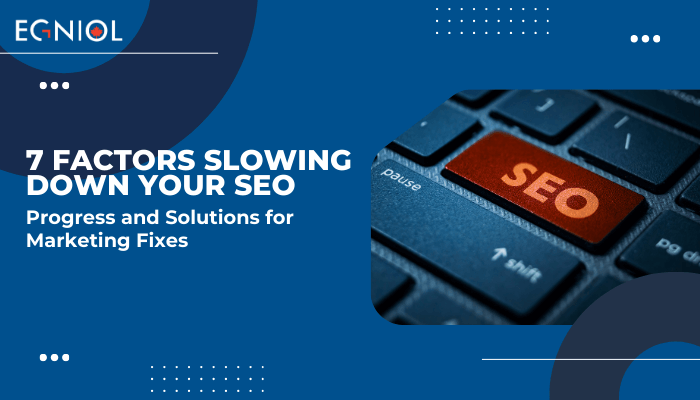You’re in a rush to leave for an important meeting, and you need to find your favorite outfit in a cluttered, disorganized closet. Despite knowing, it’s somewhere in there, the mess makes it nearly impossible to find without a thorough search. This situation mirrors what happens when your website isn’t optimized for search engines. No matter how excellent your content or services are, they won’t reach your target audience if your site is not properly organized for search engines to find and index your pages effectively. This is particularly crucial for startups and MSMEs stepping into the digital marketing arena, where 70% of businesses see SEO as more effective than PPC for generating sales. Let’s unpack the common stumbling blocks in SEO and discuss straightforward solutions to enhance your visibility online.
Factor 1: Neglecting Keyword Research
Many new businesses start their SEO with either very generic or highly competitive keywords, making it difficult to rank.
Emphasize specific, long-tail keywords that reflect the intent and search habits of your target audience. Use tools like Ahrefs or SEMrush to discover niche keywords with lower competition. For example, instead of targeting “fashion boutique,” aim for “women’s Boho fashion boutique in Atlanta,” which might have fewer searches but will have less competition and higher conversion rates. Long-tail keywords account for 70% of all search traffic, making them crucial for reaching a more targeted audience.
Factor 2: Ignoring Local SEO
Businesses with a physical presence often overlook the power of local SEO, missing out on a highly engaged local audience.
Claim and optimize your Google My Business listing, ensuring that your NAP (Name, Address, Phone number) details are consistent across all platforms. Encourage satisfied customers to leave positive reviews, and respond thoughtfully to all reviews, good or bad. Utilizing local keywords in your content can also boost local search rankings. Businesses that optimize for local SEO can increase their revenue by up to 20% annually by targeting local shoppers.
Factor 3: Website Not Mobile-Friendly
With mobile devices accounting for approximately 54.8% of global website traffic, a non-responsive website is at a significant disadvantage.
Design your website with a mobile-first approach. Ensure that it’s responsive and loads quickly on all devices. Google’s Mobile-Friendly Test can provide insights into how well your site performs on mobile devices and offer suggestions for improvement. A mobile-friendly site can improve user engagement rates by up to 50%.
Factor 4: Slow Site Speed
A slow website can lead to a poor user experience and high bounce rates. According to Google, as page load time increases from 1 second to 3 seconds, the probability of a bounce spikes by 32%.
Optimize images, minify CSS, JavaScript, and HTML, reduce redirects, and leverage browser caching. Regularly check your site’s speed with tools like Google Page Speed Insights and implement their recommendations to improve load times. Websites that reduce their load time by 1 second can see a 7% increase in conversion rates.
Factor 5: Poor-Quality Content
Low-quality, irrelevant content can damage your SEO efforts, reducing user engagement and dwell time on your site.
Create valuable, informative, and engaging content tailored to your audience’s needs. Regularly update your content to keep it fresh and relevant. Using a natural language that resonates with your audience can also improve engagement and retention. Content marketing gets three times more leads than paid search advertising.
Factor 6: Not Utilizing Analytics
Not monitoring your SEO performance can lead to missed opportunities for optimization and improvement.
Implement Google Analytics to track your website’s traffic and user behavior. Analyze the data to understand what works and what doesn’t, then adjust your SEO strategies accordingly. Monitoring key performance indicators (KPIs) will help you measure success and optimize future efforts. Companies that analyze their web data can increase their profitability by up to 20%.
Factor 7: Ignoring Meta Tags and Descriptions
Many websites fail to optimize meta tags and descriptions, which are crucial for search engines to understand the content of each page.
Ensure each page has a unique meta title and description that includes relevant keywords. Keep meta descriptions compelling and concise to improve click-through rates from search engine results pages (SERPs). Effective meta tags can increase click-through rates by up to 5.8%, compared to pages without them.
Conclusion
Just as organizing a messy closet can transform your morning routine, addressing these SEO factors can significantly enhance your website’s search engine visibility and user engagement. Take a moment to reflect on your current SEO strategies are there areas where you can improve? Consider these solutions and think about new approaches that could be implemented to better reach your target audience.
At Egniol Canada, we understand the unique challenges startups face in the digital landscape. While we’ve touched on ways you can independently improve your SEO, remember that sometimes, a little expert help can go a long way in accelerating your progress. What are the main SEO hurdles you’ve encountered, and how have you tried to overcome them? Share your experiences and let’s continue learning together in this ever-evolving digital world.
